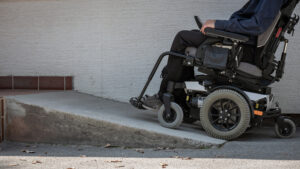Understanding The Cost of Building A Wheelchair Ramp
Wheelchair ramps are typically built to provide wheelchair users and those with mobility impairments access to a building or other location. Based on the material used to build it, the cost to build a wheelchair ramp will vary. A wheelchair ramp can be made from wood, metal, or plastic and should have a non-slip surface. Ramps should be wide enough for a wheelchair to pass through and should have handrails on both sides. The slope of the ramp should not be too steep, as this can make it difficult for people to use.
When building a wheelchair ramp, it is important to follow local building codes and safety guidelines. It is also important to consult with a mobility specialist to ensure that the ramp will meet the needs of the individual who will be using it.
 Average Cost of A Wheelchair Ramp
Average Cost of A Wheelchair Ramp
A typical wheelchair ramp costs between $1,000 and $4,000, but more complex or custom-built ramps can cost much more. The length and steepness of the ramp will affect the total cost. There are many factors that go into calculating the cost of building a wheelchair ramp, so it’s best to consult with a professional before beginning construction.
If you’re looking for a more affordable option, there are some prefabricated wheelchair ramps available on the market. These ramps typically cost between $200 and $1,000, depending on the length and steepness.
With a little bit of research, you can find the perfect ramp for your needs and budget.
Things To Consider Before Building A Wheelchair Ramp
Wheelchair ramps can be a great way to make your home more accessible for people who use wheelchairs or mobility scooters. They can provide a way for people with limited mobility to access your home independently. Before you begin construction of a wheelchair ramp, there are a few things to consider when deciding to build a wheelchair ramp.
There are many different types of ramps, and the price varies depending on the materials and construction. Generally, wooden ramps are the cheapest, while metal or concrete ramps are the most expensive. However, it’s important to remember that the most expensive ramp isn’t always the best option.
It’s also important to consider how long the ramp will need to be. If you live in a small home, a short ramp may be all you need. But if you live in a large house with multiple levels, you’ll need a longer ramp. The length of the ramp will also affect the cost.
Another factor to consider is the slope of the ramp. The steeper the slope, the more expensive the ramp will be. So if you have a tight budget, you may want to choose a ramp with a gentler slope.
you will also need to consider the weather conditions in your area. If you live in a cold climate, you’ll need a ramp that can withstand snow and ice. This will add to the cost of the ramp.
Finally, you’ll need to decide if you want a permanent or temporary ramp. Permanent ramps are more expensive, but they don’t need to be taken down and stored when not in use. Temporary ramps are less expensive, but they’re not as sturdy and can be more difficult to store.
So how much does it cost to build a wheelchair ramp? The price varies depending on the type of ramp, the length of the ramp, and the slope of the ramp.
 Wheelchair Ramp Materials
Wheelchair Ramp Materials
There are a few types of materials to choose from when building a wheelchair ramp. Wheelchair ramps come in three main types: wood, aluminum, concrete, and plastic. The most popular type is wood, as it is sturdy and relatively inexpensive. However, wood can be difficult to maintain and may not be suitable for all climates.
Wood
If you are using a wooden ramp, it is important to use pressure-treated lumber so that the ramp does not rot. On average, building a wooden wheelchair ramp will cost around $1,200.
Metal
Another option is aluminum, or metal, which is both lightweight and weatherproof. This type of ramp typically costs around $2,000 to build, but it is a good investment as it will last for many years. Metal is both durable and weather-resistant. Metal ramps are also easy to clean and can be configured in a variety of shapes and sizes. However, metal ramps can be expensive and may not be suitable for steep slopes. Metal ramps can be installed on concrete, asphalt, or wooden surfaces.
Concrete
Concrete ramps are the most durable type of ramp, but they are also the most expensive. On average, concrete ramps cost between $3,000 and $4,000 to build. Concrete is a good choice for steep slopes or if the ramp will be subject to heavy use. However, concrete ramps can be difficult to maintain and may require professional installation.
 Plastic
Plastic
Plastic wheelchair ramps are also available, but they are not as common as wood, metal, or concrete ramps. Plastic ramps are lightweight and easy to install and are usually the least expensive type of ramp. However, they are also the least durable. Plastic ramps typically cost between $500 and $1,000 to build. Plastic ramps are best suited for temporary use or for light traffic areas.
The choice of material will depend on a number of factors, including the slope of the ramp, the weight of the wheelchair, and the climate. It is important to choose a material that is both safe and durable.
When choosing a wheelchair ramp, it is important to consider the needs of the individual using it. If you are unsure which type of ramp is best for you, consult with a professional contractor. They will be able to help you choose the right ramp and ensure that it meets all safety requirements.
Building A Wheelchair Ramp
As mentioned before, the first step in building a wheelchair ramp is determining the ramp’s length and height. The length of the ramp will depend on the slope of your driveway or landing area. To calculate the slope, measure the distance from the bottom of the driveway or landing area to the top, and divide it by the distance from the bottom to the desired end point. The result is your slope percentage. For example, if the distance from the bottom to the end point is 10 feet and the distance from the bottom to the top is 20 feet, the slope percentage is 50%.
The height of the ramp will depend on how high you need it to be in order to accommodate your wheelchair or mobility scooter. You will also need to take into account the rise between each level. The rise should not be more than 6 inches.
Once you have determined the length and height of the ramp, you can begin construction. Make sure the material is long enough to span the entire width of the ramp. Start by building a frame using 2x4s, and then attach 2x6s to create the ramp surface. Make sure to use galvanized screws or nails to attach the material, as this will help prevent rusting.
If you are not comfortable constructing a wheelchair ramp yourself, you can hire a professional to do it for you. Just make sure to discuss your needs with them in advance so they can build the ramp accordingly.
Steps to Build A Wheel Chair Ramp
If you are looking for a DIY project, you could build your own wheelchair ramp. There are a few basic steps to building a wheelchair ramp:
1. Determine the length of the ramp. This is the distance from the bottom of the ramp to the entrance or door it is leading to.
2. Decide on the width of the ramp. This should be at least as wide as the wheelchair that will be using it.
3. Purchase lumber and hardware. You will need to buy lumber for the frame of the ramp, as well as screws, nails, hinges, and other hardware.
4. Construct the ramp frame. The frame is made up of two parallel sides (or “rails”) with a landing pad in the middle. The rails should be set at an angle so that the ramp slopes down gradually from one end to the other.
5. Install the landing pad and railing (if desired). The landing pad is a flat surface at the bottom of the ramp where people can stop and rest before continuing up the ramp. A railing can also be added if needed for safety.
6. Finish the ramp surface. The surface of the ramp should be smooth and even, with no bumps or holes.
7. Add a safety strip (optional). A safety strip is a narrow piece of material (usually rubber or vinyl) that runs along the edge of the ramp to prevent people from slipping off.
8. Test the ramp for stability and safe use. Once everything is finished, it is important to test the ramp to make sure it is safe and stable. Have someone walk or roll up and down the ramp to make sure there are no sharp edges or other hazards.
9. Enjoy! Now you can use your wheelchair ramp to easily get in and out of your home or business!
